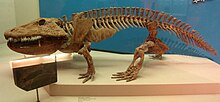This article includes a list of general references, but it lacks sufficient corresponding inline citations .(September 2022) |
| Eryopidae | |
|---|---|
 | |
| Cast of a skeleton of Eryops megacephalus , National Museum of Natural History | |
| Scientific classification | |
| Domain: | Eukaryota |
| Kingdom: | Animalia |
| Phylum: | Chordata |
| Order: | † Temnospondyli |
| Superfamily: | † Eryopoidea |
| Family: | † Eryopidae Cope, 1882 |
| Genera | |
| |
Eryopidae were a group of medium to large amphibious temnospondyls, [2] known from North America and Europe. They are defined as all eryopoids with interpterygoid vacuities (spaces in the interpterygoid bone) that are rounded at the front; and large external nares (Laurin and Steyer 2000). Not all of the genera previously included in the Eryopidae (Carroll 1988) are retained under the cladistic revisions.






